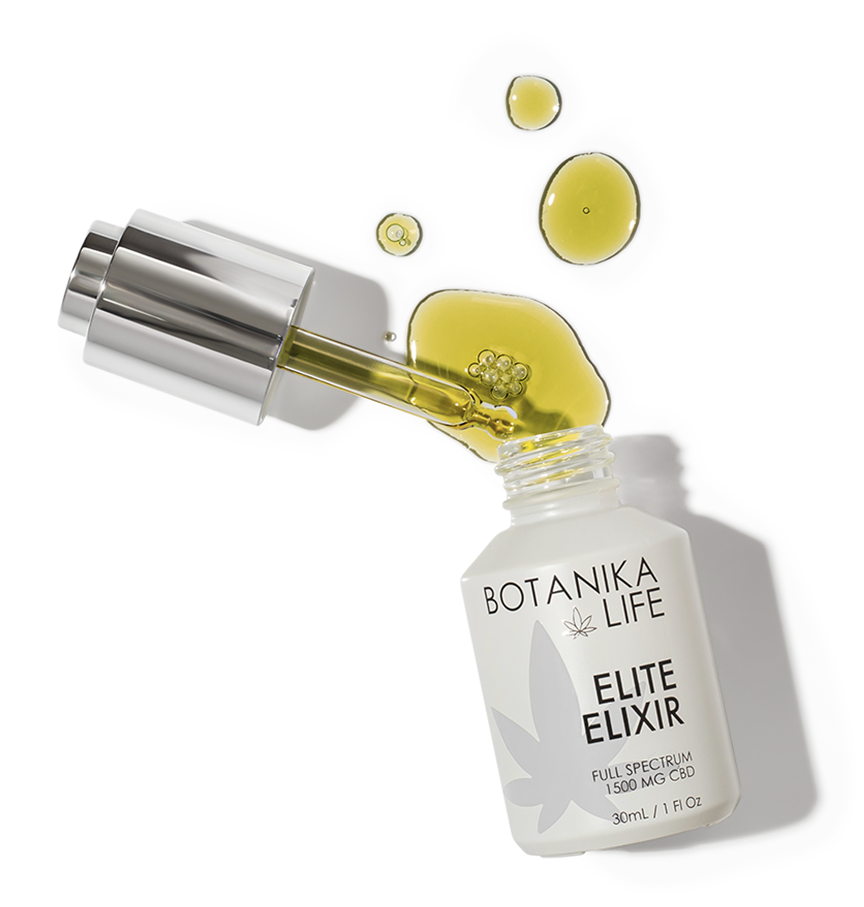
How CBD Interacts with Your Body and Its Effects
Now is the era of the informed beauty, wellness, and skincare consumer! It’s essential to consider sustainability, animal testing practices, and the general socioeconomic impact of the companies you support. However, above all else, it’s crucial to understand the exact ingredients, from their source to the general effects.
In this spirit, we wanted to provide an in-depth look at how CBD interacts with your body so you can consume and/or topically apply it confidently.
Basic positive effects of using CBD
There are four sought-after primary effects that CBD can provide for your mind and body: the support of a healthy sleep cycle, reduction of stress and anxiety, pain relief and prevention, and skincare. Here’s how it works:
Support for a Healthy Sleep Cycle
A good night's sleep is crucial to maintaining healthy brain function, as sleep is when the body heals and recovers physically, mentally, and emotionally. Poor sleep cycles have been directly linked to negative health outcomes such as high blood pressure and depression. Taking CBD can help reduce stress and chronic pain, both which interfere with a healthy sleep cycle.
Pain Relief and Prevention
One of CBD's most sought-after and exciting effects is its ability to reduce inflammation and pain in the body. Studies show that individuals suffering from chronic pain find that CBD helps to manage their symptoms and make their pain less noticeable. Pain and inflammation can make everyday life unbearable, and traditional prescription pain medications can be dangerous and highly addictive. CBD is an all-natural way to treat all types of pain, including pain from arthritis, sports injuries, and autoimmune disorders. Botanika Life offers a complete line of CBD pain relief products that delivers the healing properties of CBD directly to the source for rapid, targeted relief.
Want to learn more about the pain-relieving effects of CBD? Check out our articles about CBD for muscle tension and CBD for neck and shoulder pain.
Reduction of Stress and Anxiety
Studies show that the calming properties of CBD can help individuals manage feelings of anxiety. When combined with other healthy stress management solutions, such as meditating, journaling, or exercising, CBD oil can play an important role in making you feel less anxious. To reduce stress, restore balance, and relax your body, look for CBD products that are blended with calming botanicals like eucalyptus or lavender. The natural compounds that give these ingredients their scents are called terpenes, and they can help you feel more relaxed and less stressed.

Skincare Improvements
The effects of CBD on the body are widespread and extend to your complexion. It provides a surge of antioxidants, helping to safeguard skin from free radicals. CBD also regulates sebum production to prevent breakouts, boosts collagen generation, and locks in moisture for more youthful appearances. Intrigued? Check out popular elixirs, such as our Vitamin C & CBD serum and our CBD acne spot treatment.
Diving Deeper Into the Science Behind How CBD Interacts With Your Body

CBD engages the body’s endocannabinoid system, which is responsible for maintaining biochemical and physiological harmony. Endocannabinoids are molecules produced by the body, on demand, and unlike other neurotransmitters like serotonin and dopamine, are not stored. They are also hydrophobic, which means they do not travel far from where they are produced.
Once endocannabinoids are manufactured, they utilize the extensive network of cannabinoid receptors throughout the body. These receptors help endocannabinoids bring balance to tissues in every body's other system, including the digestive, immune, nervous, and endocrine systems. This is why the endocannabinoid system is collectively as crucial as the rest.
Let’s take a moment to look at the types of cannabinoid receptors located within the body, which are:
CB1: These receptors are concentrated mainly in the brain, central nervous systems, and primary organs. They can deal with fundamental processes, including sleep, digestion, mood, appetite, coordination, and memory.
CB2: These receptors are concentrated in the immune and peripheral nervous systems and reproductive organs. They affect pain and inflammation.
Taking this a step deeper, let’s discuss how CBD fits into all of this. We already know that CBD engages with the endocannabinoid system, but how? Instead, of engaging directly with these receptors, it works with the actual endocannabinoids our body produces. Similar to how electrolytes and antioxidants boost the production of important elements our body already manufactures on its own, CBD does the same with endocannabinoids.
The science behind the vast array of effects of CBD can seem a little daunting and complicated. Still, there are several important molecules that CBD interacts with inside the body that makes these outcomes possible. Here’s a brief breakdown of those molecular receptors:
Anandamide: The name of this molecule is derived from the Sanskrit word for bliss, and as a neurotransmitter, it sends messages between nerve cells. The name came about because anandamide influences the areas of the brain that deal with pleasure and happiness. It also affects cognitive and sensory functions.
CBD increases anandamide production, which plays a large role in managing stress and regulating sleep.
2-arachidonoylglycerol or 2-AG: This receptor works much of the same as anandamide. As a neurotransmitter message sender, it’s important to realize the job that both 2-AG and anandamide do, because they do not just send messages one way. They can transmit the message to start a neuron firing, but also to do the opposite, and stop.
A critical distinction between anandamide and 2-AG, is that while both attach to the CB1 receptor, only 2-AG is also a full CB2 agonist, which means it binds to both types of receptors. CB2 receptors are the ones that engage with the body’s immune and inflammation systems, so not only can 2-AG act as a neurotransmitter, but it produces an anti-inflammatory and immune response.
TRPV1: This receptor is part of a larger receptor subfamily that moderates how people feel and process pain. The capsaicin compound primarily binds to this receptor upon entering the body. Why should capsaicin sound familiar to you? The compound is found in chili peppers, and is responsible for the spicy sensation they produce. It’s also a fantastic anti-inflammatory, used in many arthritis and pain relief rubs that can be used for workout recovery, and other minor joint and muscle injuries, especially for athletes.
The interesting thing about this receptor is that it functions to cause searing pain, but the over-stimulation of the receptor then desensitizes, and causes the exact opposite reaction. If you’ve ever eaten chili peppers, where the first few seem unbearable, but then it almost feels as if your mouth and lips are experiencing a numbing reaction, you’ve encountered the activation and desensitization of the TRPV1 receptor.
GPR55: The discovery and understanding of the workings of the GPR55 receptor, as they are connected to the endocannabinoid system, and the variety of functions it can be responsible for influencing, are fairly new within the medical and scientific community. The receptor was first discovered in 1999, and the link to its crucial role in the endocannabinoid system made in 2007.
These receptors have roles in inflammation, as well as neuropathic pain, bone health, and diabetes. CBD acts as an antagonist to these receptors, which means it inhibits or suppresses them. Therefore, CBD allows the body to produce an opposite, beneficial response.
Of course, CBD is not a replacement for some long-held traditional medical treatments. The inclusion of CBD with these treatments can only serve to improve quality of life, and provide therapeutic assistance when we most need it.
PPARS: This receptor overlaps with the GPR55 receptor, in that it can affect glucose, metabolism, and inflammation. However, CBD acts as an agonist for PPARS, so it triggers and boosts the advantageous results of engaging the receptors.
Some of the conditions that PPARS agonists can possibly help improve or control, such as diabetes, energy balance, neurodegenerative disorders, and neuropathic pain.
Are There Negative Interactions CBD Has With the Body?
Generally, the negative effects of CBD on the body are minimal. Topical applications of CBD work almost immediately and do not have bioavailability, so they only interact with the endocannabinoid receptors within the skin. However, when you ingest CBD in any way, there is a degree of digestion and metabolization that has to happen.
The family of enzymes CYP450 is responsible for metabolizing some cannabinoids, and a lot of prescribed medications. Therefore, taking CBD can possibly inhibit the proper metabolization of these medications. It’s worth it to note that there are everyday foods, like grapefruit, that also have this same issue.
The flexibility of CBD means there are many choices for use, so it just means that you need to inform yourself about the available ways a particular CBD product accesses the endocannabinoid receptors, and how and how much metabolization is needed.
FAQ About How CBD Interacts With Your Body
Still have questions about how CBD interacts with your body? Below are answers to common questions about the effects of products.
Does CBD have an intoxicating effect?
No. CBD is non-intoxicating due to the way the body absorbs it. CBD does not enter the bloodstream in the same way as intoxicating medications and drugs. While CBD can have bioavailability, it interacts with the body mainly through receptors called endocannabinoids, which are part of the body’s system of the same name.
How long do the effects of CBD last?
Several determinates can change this number, but for the most part, a dose of CBD can last from 2-6 hours. Why the range? Everyone’s body has its own metabolic rate, so it’s hard to give a specific length fof time. There are also different ways to take CBD. Some that require a degree of digestion via the liver, like gummies or pills, will not show effects immediately and may also have lessened efficacy.
Is CBD safe to take with prescription medication?
This question has nuance to it. Of course, some medications can reduce the effects of CBD and vice versa. This is something that happens with anything, though. Contraindications are important to know, and one of the easiest ways to find out risks is to keep your doctor apprised of any medicinal or health changes you make, or are considering.
Can CBD be absorbed through the skin?
Yes, CBD can be absorbed through the skin. In fact, this is one of the most effective methods for delivering pain relief directly to the anguished area rather than distributing it throughout your entire body.
Final Thoughts About the Bodily Effects of CBD
When it comes to your body, mindfulness can help you stay in touch and in sync with even minor changes to your health, whether physical, emotional, or mental. The bottom line:
- Keep yourself aware of all the products you use, and if an adverse effect happens, discontinue use immediately.
- Keep yourself aware of all the ingredients (not just the first few listed) and if you’re unsure what something is or does, google it!
- Look for companies that take your concerns seriously and provide transparency on what ingredients they use, and share the same values as you.


